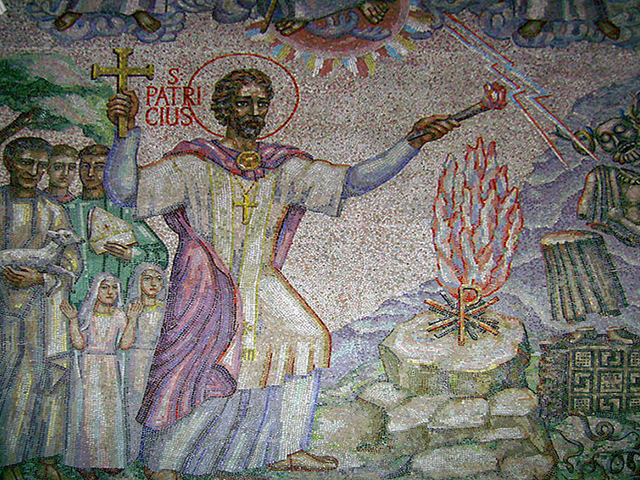A Brief History of Fed Expectations Overturned
As the Federal Reserve prepares to convene next week, let’s not overlook the serendipitous timing of their gathering, nearly coinciding with the jovial festivities of St. Patrick’s Day. Perhaps some of the courage of the patron saint of Ireland will inspire our central bankers.
Federal Reserve Chairman Jerome Powell’s surname is Welsh in origin, not Irish. It is derived from the Welsh name Hywel, with the Welsh prefix ap appended at the start in the same way Mac or O would be in other parts of the Celtic realm, indicating son of. The name Hywel means, we are told, something like eminent. His mother was born Patricia Hayden, which we suppose gives him at least a passing connection to St. Patrick.
The Fed has been unlucky in recent months. Through the summer and fall of 2023, the Fed held firm to a stance of determined ambivalence. The central bank held its benchmark rate steady after a final hike in July, while publicly preserving the notion that monetary policy might need to tighten further to bring inflation down to the two percent target.
In December, the Fed very publicly pivoted off this view. It indicated that it was no longer pondering increasing rate hikes but determining the timing of a rate cut. This set off such a frenzy of speculation that rate cuts might be coming right away that in January the Fed felt it necessary to all but promise not to cut at the March meeting. The Fed said it needed further evidence and more confidence that inflation is sustainably headed to target.
While that introduced a bit of sobriety to bond markets, pushing down expectations for this year’s rate cuts from the five or six that had been priced in to something closer to the three Fed officials had penciled in back in December, it was clear that Fed officials still believed that the next move would be a cut. More than that, it was clear that Fed officials want to cut and are looking for the opportunity to cut.
Inflation marched through February and January like a parade’s grand marshal, determined to move the throng forward despite signs that some of the spectators had arrived early to their intended states of inebriation. The index for core inflation rose a spritely 3.8 percent year-over-year. Annualizing the past three months, taken in isolation, raises this number at an even more spirited 4.2 percent. If we annualize just the more recent figure, we see that core inflation rose at a rate of 4.2 percent.

A police band marches in the St. Patrick’s Day Parade down 5th Ave. on March 17, 2022, in New York City. (Spencer Platt/Getty Images)

Spectators wear Irish-themed accessories during the 2022 St. Patrick’s Day Parade on March 17, 2022, in New York City. (Roy Rochlin/Getty Images)
There is some irony that the arcane and mysterious subdivisions recently invented to show that inflation was not really rising all that much are now pointing in the opposite direction. Jerome Powell and many Wall Street analysts had latched on to the idea of looking at core services excluding shelter as an indicator of underlying inflationary pressures. In February, this rose at an annualized rate of 6.2 percent, with the three-month annualized rate at 6.4 percent and the six-month annualized rate at 5.8 percent.
In short, the signs of confidence the Fed set out in search of in January were not forthcoming in the weeks that followed. While inflation does not yet appear to be threatening to return to the worst months of Bidenflation, it is not yet ready to ring the bell for last call that would signal a time for a rate cut.
This is causing some to reconsider the Fed’s venerated “neutral” rate, that economic North Star guiding the ship of policy through turbulent waters. This rate is purportedly the dividing line between stimulus and restraint, yet it eludes direct measurement, cloaked in the mystique of econometric models. Our central bankers have proclaimed for five years now that the longer run rate for federal funds is 2.5 percent, just half a point above their inflation target.
We have lately begun to hear notes of dissent sung from within the hallowed halls of the Federal Reserve itself. What if, some maverick voices suggest, the neutral rate has embarked on a celestial creep upwards, unbeknownst to the terrestrial beings below? This is what Minneapolis Fed President Neel Kashkari has hinted at recently, perhaps feeling more able to speak freely because he is not a voting member of the Federal Open Market Committee this year.
If the neutral rate is higher than thought, that would mean current policy is not as restrictive as thought.
Biden’s Misbegotten Bet
President Joe Biden recently proclaimed that he expects the Fed—which he derisively referred to as “that little outfit that sets rates”—to cut rates.
“I can’t guarantee it. But I bet — you betcha — those rates come down more, because I bet you that that little outfit that sets interest rates, it’s going to come down,” Biden said last week in a speech in Philadelphia.
And here is where the Fed needs to take up the way of St. Patrick, who defied the decree of the High King that no flame should dare precede the royal beacon. With a conviction as deep as the ancient hills that cradled him, St. Patrick struck a spark, kindling a fire whose glow would pierce the mantle of night and challenge the edicts of kings. This was no mere earthly flame; it was a testament, a beacon of faith that burned fiercely against the gathering gloom, heralding the dawn of a new era.
In the act of lighting the Paschal fire, Patrick did not merely defy temporal authority. He illuminated a path, casting light upon the shadows of a land ensnared by the tendrils of old beliefs. This fire, resolute and pure, spoke of resurrection, of renewal, of a world reborn through the grace and mystery of the divine.

This mosaic by Boris Anrep in Christ the King Cathedral in Mullingar, Ireland, depicts Saint Patrick lighting the Paschal fire. (Photo by Peter Gavigan/Wikimedia Commons)
And so, as the stars wheeled overhead and the people of Ireland beheld this spectacle, a transformation began. Hearts stirred, minds awakened, and the ancient isle, cradled in the arms of the sea, found itself at the threshold of a new awakening, guided by the light of Patrick’s fire, a flame that endures in the soul of a nation.
In the soft, lingering twilight of that Irish eve, in that moment of quiet defiance— a gesture so profound yet so serene—there unfolded a miracle whose energy meanders still through the warp and woof of time.
Powell can live up to his Welsh name, earn the eminence of his forefathers, by leading the Fed to stand athwart Biden’s predictions. To start, the Fed could bring down the forecast of rate cuts this year from three to just one or two. Going further, Powell could re-sculpt the shape of monetary policy by announcing that he too can see that the stars have shifted and the neutral rate may be higher than has been thought.
This would be more than a technocratic tweak. It would be a gambit in a grander strategy to restore the credibility of monetary policy and perhaps repair some of the rents in the political and social fabric of our nation.
As we don our green and raise our glasses this March 17, let us hope those fine fellows and lauded ladies at the Fed find comfort in the courage and wisdom of St. Patrick. And perhaps with a bit of the luck of the Irish, we’ll come through the current mess before too long.

COMMENTS
Please let us know if you're having issues with commenting.